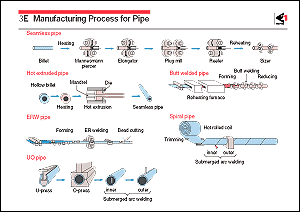Steel tubes and pipe can be broadly
categorized according to manufacturing method as seamless tubes
and pipe made by hot rolling or hot extrusion, and welded pipe
and butt-welded pipe made by bending and welding sheets or plates.
When seamless pipe is made by rolling, the rolling method involves
piercing the material while it is being rolled, and is suitable
for mass production. The figure shows the manufacturing process
used in the Mannesmann plug mill, which is a typical rolling
process. The Mannesmann-type piercer reduces the material by
rolls that are inclined obliquely to each other. When the round
billet is rotated while being compressed in the diametric direction,
the central part of the billet becomes loose, which makes it
easy to pierce a hole through the center. This is called the
Mannesmann effect. The pierced portion is expanded by the elongator,
and the wall thickness is then thinned and elongated by the plug
mill. The internal and external surfaces are smoothed by the
reeler, and the final dimensional adjustments are made by the
sizer.
The hot-extrusion method involves working in the compressive-stress
field. Therefore, it is characteristic of this method that high-alloy
steel pipe of low deformability can be produced, as well as heavy-wall
and large-diameter pipes.
Seamless pipe has outstanding homogeneity in the circumferential
direction and is thus highly resistant to internal pressure and
torsion. Taking advantage of this feature, seamless pipe is
widely used for drilling and pumping petroleum and natural gas.
Welded pipe is divided into electric-resistance welded (denoted
ERW hereinafter) pipe, spiral pipe, and UO pipe according to
the forming and welding method. ERW pipe and butt-welded pipe
are produced by continuously forming a hot-rolled coil into a
tubular shape by forming mills. ERW pipe is produced by cold
forming, and the seam is welded by electric-resistance welding.
This type of steel pipe is used in large quantities as line
pipe for transporting petroleum and gas. Butt-welded pipe is
produced by hot forming after the whole material has been heated,
and seams are then butt welded. This type of pipe is hot-dip
galvanized and used for carrying water and gas.
The outer diameter of ERW pipe and butt-welded pipe is determined
by the width of the material coil. However, as shown in the
figure, spiral pipe is made by forming the coil into a spiral
shape, which makes it possible to obtain a large outer diameter
regardless of the width of the material. UO pipe is usually
large in diameter and produced one piece at a time by forming
plates. The plate is first pressed into a U shape by the U-press,
and then into an O shape by the O-press.
Because relatively thick material is used for making spiral and
UO pipes, submerged arc welding is used for joining. The principal
application of spiral pipe is pipe piles. UO pipe, as mentioned
above, is mainly used as line pipe for transporting petroleum
and natural gas in large quantity over long distances. |
|
 |
 |
 |
|
|